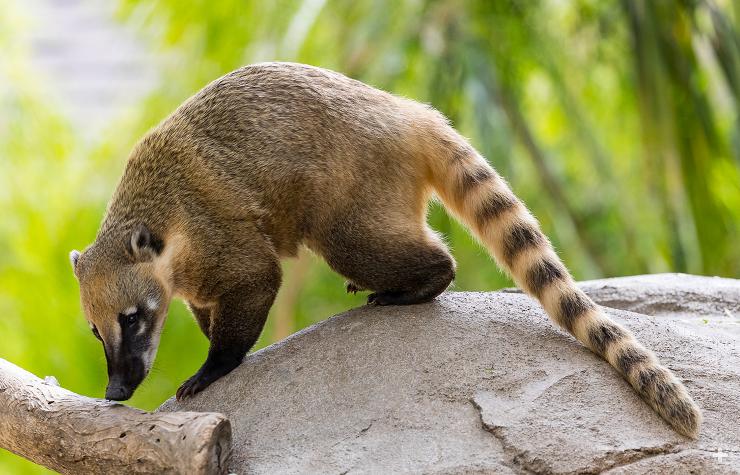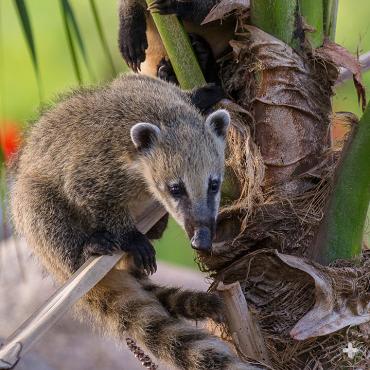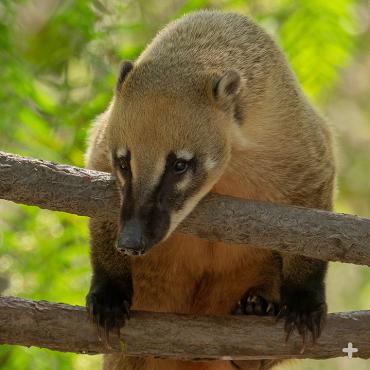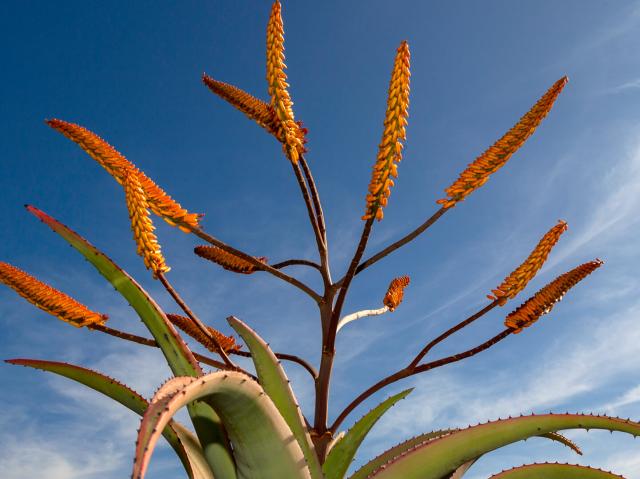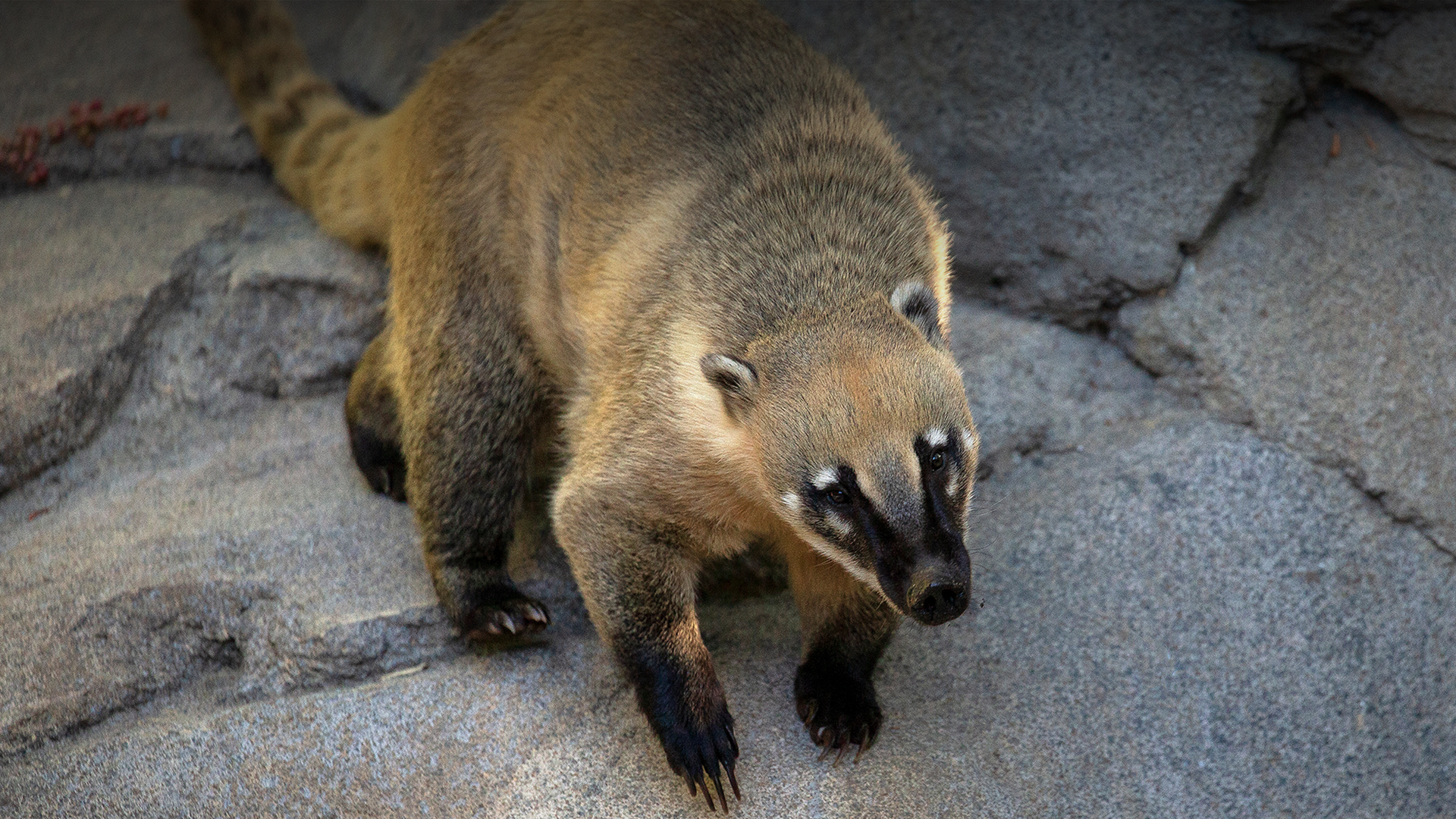
Coati

- Class: Mammalia
- Order: Carnivora
- Family: Procyonidae
- Genus: Nasua; Nasuella
- Species: (Nasua) narica, nasua; (Nasuella) olivacea, meridensis

ABOUT
The coati is an agile, fruit-loving, meat-eating insectivore—an opportunistic omnivore—that is as at home in the trees as it is snuffling along the forest floor. Weighing as much as a large housecat, these mostly diurnal mammals are native to Central and South America, and parts of the southwestern US. Visually, the coati resembles a cross between a dog, a monkey, and a raccoon. It is related to the racoon.
Wherever they live, coatis play an important mid-level role in food chains. They consume a wide range of insects, invertebrates, and plant matter (fruit, nuts, roots, leaves), and small vertebrates. They are prey for wildlife like jaguars, ocelots, jaguarundis, foxes, boas, birds of prey, and even humans. Being mid-food chain has its perks…and its downside.
With its tail up posture, long, mobile snout, and formidable front claws, the coati sniffs along the forest floor in search beetles, grubs, ants and termites, spiders, scorpions, centipedes, frogs, lizards, and other assorted prey. Its long, muscular, semi-prehensile tail helps it balance in the trees; on the ground its tail usually stands straight up, perhaps helping them keep track of each other in the vegetation.
Four’s company. There are four types of coatis (pronounced ko-AH-teez), two in the Nasua genus and two in the Nasuella genus. The white-nosed coati Nasua narica ranges from Arizona to northwestern Colombia; N. nasua ranges from Colombia to northern Argentina and Uruguay.
The mountain coati Nasuella olivacea ranges from the Andes of western Venezuela, Colombia, Ecuador, and northern Peru. It appears to be uncommon across its range; its upland forest habitat is being converted to agriculture and pine plantations, putting more pressure on the coati. Nasuella meridensis lives in northern Venezuela, and it is Endangered.
Name it. According to The Encyclopedia of Mammals, coati is not short for "coatimundi." Females and their young form bands of 20 individuals or more, while adult males are solitary. This difference in social structure (and males being larger than females) confused biologists, who initially described the solitary males as a separate species. The use of “coatimundi,” meaning “lone coati” in Guarani (an Indigenous language of Brazil), for males reflects this error. Now, only lone males are sometimes called coatimundi, although they are coatis, too.
Use your head. In an elegant study that appeared in “Brain, Behavior and Evolution,” scientists compared brain size of males and females in three procynonid species: raccoons, kinkajous, and coatis. The only sex difference in neural brain tissue was in the social coatis. Females possessed a larger frontal cortical volume than their male counterparts due to their expanded, lifelong social ties. It takes brain power to make and keep friends! The study supports the principle that “behavioral specializations correspond to an expansion of neural tissue involved in that function.” Hopefully, female coatis won’t get a big head about it.
Put some rings on it! The mountain coati’s elongated body is grayish sooty brown with a notable bushy tail that is ringed with yellowish gray and dark brown bands. Its flexible, pointed, pig-like snout, used for sniffing out food under leaf litter and in crevices, has earned it the nickname “hog-nosed raccoon.” The coati has double-jointed ankles which can rotate 180 degrees which allow it to climb down tree trunks head first. Strong front claws are ideal tools for excavating grubs, lizards, and spiders from logs and burrows.
HABITAT AND DIET
Flexi home. Coatis enjoy wide-ranging habitat types including tropical lowlands, dry high-altitude forest, oak forest, mesquite grassland, and forest edges. The forests of the Colombian Andes support two coati species: Nasuella olivacea and Nasua nasua. The mountain coati may be found at 6,500 feet (2,000 meters) and more abundant at 9,800 feet (3,000 meters) in Andean forests and high páramos (barren plain). At home in the trees and on the ground, coatis may inhabit areas near humans, and tourists may be treated to a band scampering through their hotel grounds.
Nursery nest. While coatis may build rudimentary roosts in the trees for nighttime sleeping, pregnant females build sturdy, elaborate nests in which to have their young. Following the breeding season in February and March, females leave the band and build a nest in a tree, where she gives birth to 2 to 7 altricial (helpless) babies after a gestation of about 77 days. She will nurture the little ones for about six weeks before rejoining the band and “introducing” her offspring. Through reciprocal altruism, females all help each other protect and raise the young.
High life. Like Nasua, the mountain Nasuella likely forages opportunistically on insects, small vertebrates, and fruit. Even carrion can make the cut! Their diet may change over time, as juveniles plump up on invertebrates and fruit, while adults bulk up on vertebrates. Male coatis forage alone, so they likely can catch more lizards and rodents; females foraging in bands use their powerful olfactory sense to detect beetles, grubs, termites and other “small subsoil wildlife” in their habitat. They may also catch frogs, lizards, and mice, on a good day.
FAMILY LIFE
Staying busy. Coatis are diurnal and maintain territories. Females stay active in their band looking after youngsters, finding food, and socializing. There appears to be a dominance hierarchy within the group; grooming helps establish bonds. Adult males are solitary most of the year and do not help raise young, so their “to-do list” is much shorter. Finding enough to eat is always a top priority.
Watch out! The mountain coati faces a range of threats related to Andean biodiversity loss. In many areas, it is considered a pest due to its occasional predation of chickens and damage to potato crops. Coatis are also hunted for their meat and fur; they may also be collected as pets, though not for the light of heart due to their lifelong curiosity, strength, agility. As pets, they have been likened to keeping a strong, super smart toddler who never grows up. However, coatis are wildlife, and should not be kept as pets.
Coatis can defend themselves from predators with their mighty dexterous front feet and claws. They may be taken by (or at least interact with) Andean bears on occasion, another opportunistic feeder.
Woof, chirp, groom. Females are far more social than males year round, but males need to make their needs known in a short period of time for breeding purposes. They try to groom adult females in a band and appear submissive to them to entice breeding. Coatis have a broad range of communications, including chirping, grunting, and snorting. When startled, they have been observed to leap into a tree, making clicking and woofing noises.
Females use a barking vocalization to warn bandmates of danger. They make a whimpering sound to keep their young close by during the weaning period. Males use scent to establish territories and fend off rivals during the mating season.
Grooming is used by males to endear them to females for breeding. Females use grooming to establish and cement bonds with other adult females in her band.
Audition for the band. Females live in groups, called bands, along with their young. Males leave the band at around two years old to live a solitary life, until the breeding season, when they groom their way back into the females’ good graces…temporarily. After breeding, which occurs in the trees, females become aggressive toward the males and drive them out of the band, lest they attempt to kill their young (infanticide) and jeopardize the next generation. Males go back to a solitary bachelor life.
Males tend to be more nocturnal, perhaps to better protect themselves from predators since they do not have the luxury of “safety in numbers” as females do. Also, this strategy allows adult males to minimize resource competition and maximize foraging efficiency.
At around six weeks of age, mothers rejoin their group with their youngsters, and females cooperatively protect and raise the little ones. Studies have shown that during the nesting season, a lone female devotes about 18 percent of her foraging time to watching out for danger—and once she rejoins the band, vigilance only takes up about 10 percent of her time.
Females reach maturity in their second year, and can remain in their natal group. Males reach maturity in their third year and must hit the road.
CONSERVATION
Both species of mountain coatis Nasuella are in decline, and is endangered, and the eastern mountain coati N. meridensis is Endangered. Main causes include deforestation, expansion of agriculture, vehicle strikes, and hunting. Habitat fragmentation also poses significant challenges to populations. While all types of coati are somewhat flexible in habit, they do require forests to live.
By supporting San Diego Zoo Wildlife Alliance, you are our ally in saving and protecting wildlife worldwide.
Life Span
7 years in the wilderness; up to 14 years in expert care
Young
Gestation: 77 days
Weight at birth: 3.5 to 6.4 ounces (100 to 180 grams)
Number of young: 4 to 6
Size
Length: almost 20 inches (50 centimeters); tail 11 inches (30 centimeters)
Weight: 2.2 – 3.3 pounds (1 – 1.5 kilograms)
FUN FACTS
A coatimundi’s ankles rotate 180 degrees, enabling it to climb down a tree head first.
They are known for their strong, nimble claws and keen intelligence.
Ancient Mayan people revered coatimundis, believing they could talk and possessed supernatural powers.
Coatimundis are part of the raccoon family, Procyonidae, along with red pandas, ringtails, kinkajous, and olingos.


